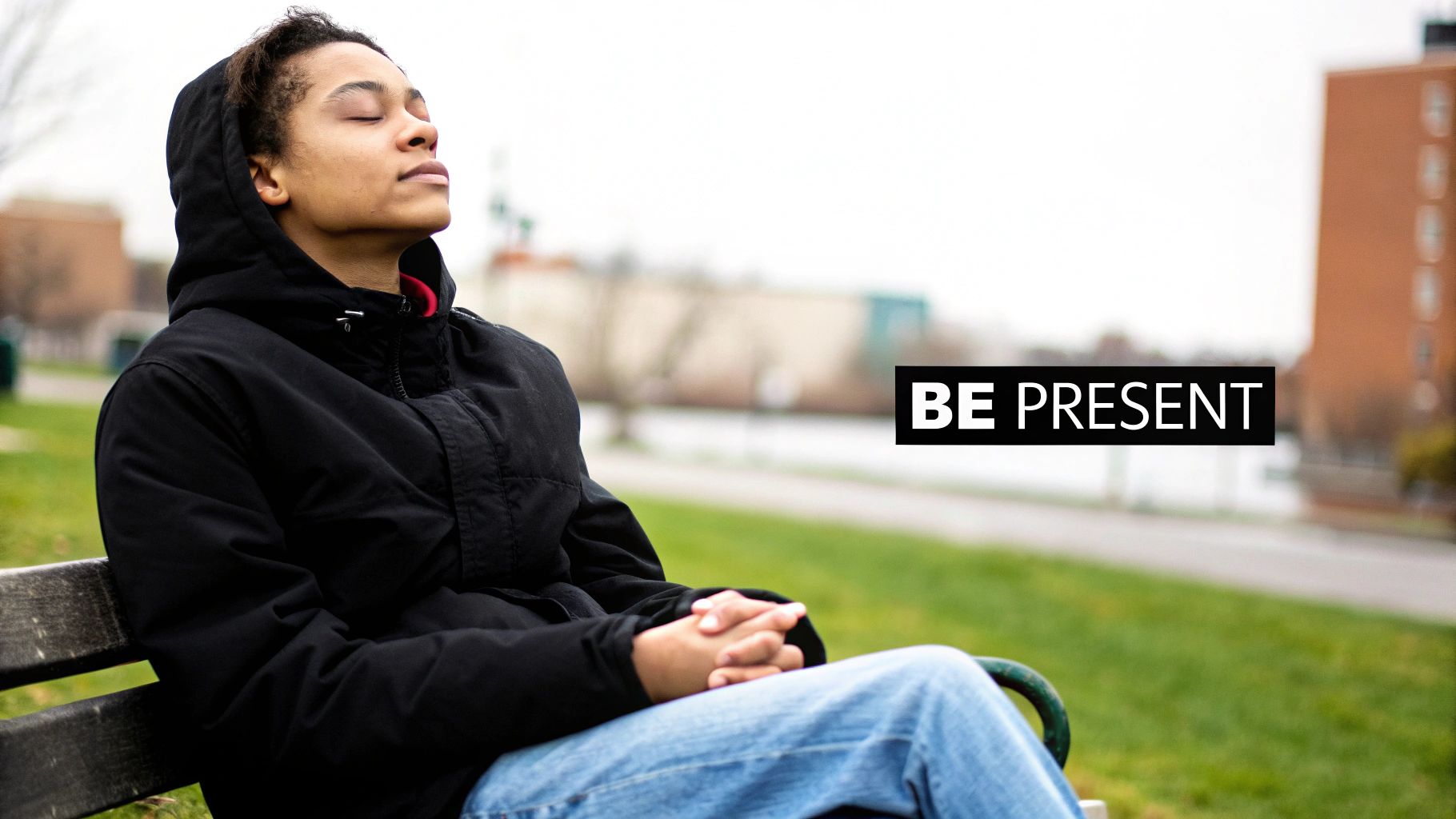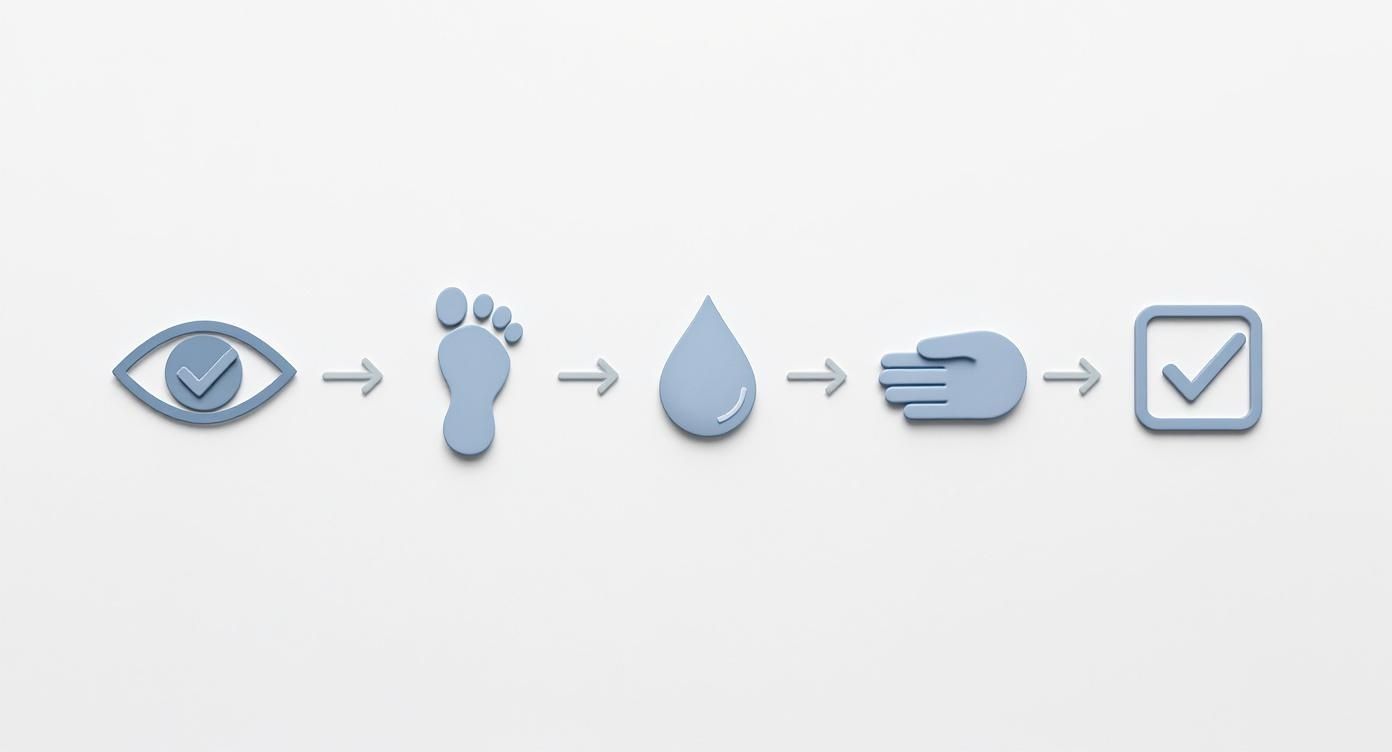Learning how to be present isn’t some mystical state reserved for monks on a mountaintop. It’s a practical skill, a way to find a little bit of calm in a world that feels like it’s constantly yelling.
It’s about intentionally pulling your focus away from the regrets of yesterday or the anxieties of tomorrow and anchoring it, firmly, in the here and now. The simplest way in? Your own senses and your own breath. They’re the most immediate tools you have to ground yourself, right now.
What It Really Means to Be Present

Let’s get one thing straight: being present doesn’t mean emptying your mind or achieving some perfect state of zen. It’s far more accessible. It’s the simple, deliberate act of paying attention to this very moment, without judging it.
It’s feeling the warmth of your coffee mug in your hands. It’s truly hearing what a friend is saying instead of just waiting for your turn to talk. It’s noticing the breeze on your skin during a short walk. That’s it. That’s the practice.
Our minds are natural wanderers. They drift to to-do lists, replay old conversations, and script out future scenarios that may never happen. This mental “time travel” is a huge source of our daily stress and disconnection. When you’re constantly thinking about what’s next, you miss what’s happening right now. The result is a life lived on autopilot, where days blur into one another and genuine connection feels just out of reach.
This is why so many people are actively trying to cultivate more presence. There’s a quiet but powerful shift happening, with the number of people practicing meditation expected to jump from 29% in 2018 to 35% by 2025. Younger generations are really leading the charge; about 40% of 18- to 24-year-olds are already practicing mindfulness, recognizing its power in a demanding world. You can find more details in this report on the global rise of meditation.
The Three Pillars of Presence
You don’t need complicated rituals or expensive retreats to learn how to be present. It starts with three core ideas you can practice anywhere, anytime.
These foundational techniques are your entry point into cultivating a more grounded awareness. Think of them not as rules, but as simple, repeatable actions that bring you back to yourself.
| Technique | What It Is | Why It Works |
|---|---|---|
| Sensory Anchoring | Intentionally noticing what you see, hear, smell, taste, and touch right now. | Your senses are a direct line to the present moment. They pull your awareness out of your head and into your physical environment instantly. |
| Breath as a Reset | Focusing on the physical sensation of your breath moving in and out of your body. | Your breath is always with you, a constant and reliable anchor. Focusing on it calms the nervous system and brings you back to your body. |
| Curious Observation | Looking at your thoughts, feelings, and surroundings with curiosity instead of criticism. | It allows you to notice your internal state without getting swept away by it. You see thoughts as just thoughts, not absolute truths. |
By returning to these three pillars, you build the mental muscle needed to stay present, even when life feels chaotic.
Think of it this way: Being present isn’t about stopping the waves of thoughts from coming. It’s about learning how to surf them.
It’s an active, engaged state of awareness. It empowers you to navigate life with more focus and calm, one moment at a time. This simple shift turns “being present” from another chore on your to-do list into a practical tool for living a more connected and fulfilling life.
Simple Exercises to Ground Yourself Anywhere
Learning to be present isn’t some mystical skill reserved for silent retreats. It’s a practical tool you build, moment by moment. The best part? You don’t need a special cushion or a quiet room to start. The most powerful grounding exercises are the ones you can do quietly, anywhere, to pull your mind back from the chaos and into the real world.
Think of these as your emergency toolkit for life. You can use them while stuck in a long grocery line, sitting through a tense meeting, or feeling that familiar wave of overwhelm in a crowded space. The goal is to have a few go-to methods that feel like second nature, ready to bring you back to center.
The 5-4-3-2-1 Sensory Method
This is one of the quickest and most effective ways to slam the brakes on a racing mind. The 5-4-3-2-1 method works by forcing your brain to stop spinning on abstract worries and start noticing what’s actually around you. It’s hard to be lost in anxious thoughts when you’re actively cataloging your environment.
Here’s how it works, wherever you are:
- Look for 5 things you can see. Don’t just glance; actually notice them. The scuff mark on your shoe, a crack in the ceiling, the way light hits a glass of water, the color of a colleague’s pen.
- Acknowledge 4 things you can feel. Tune into the physical sensations you usually ignore. The texture of your chair, your feet pressing into the floor, the soft fabric of your sleeve, the cool metal of your watch.
- Listen for 3 things you can hear. Filter out the noise and pick out specific sounds. The low hum of a computer, distant traffic, your own quiet breathing, the muffled sound of a conversation nearby.
- Notice 2 things you can smell. This one can be subtle, which is part of the point. Maybe it’s the faint scent of coffee, the soap on your hands, or the smell of rain outside.
- Identify 1 thing you can taste. This could be the lingering taste of mint from your toothpaste, a sip of tea, or just the neutral taste in your mouth.
This method is a reliable circuit-breaker for anxiety because its structure is so simple to remember, making it a lifeline when you feel your thoughts starting to spiral.
Micro-Practices for Everyday Moments
Being present doesn’t mean adding another chore to your to-do list. The real change happens when you weave small moments of awareness into things you’re already doing.
Mindful Hand Washing
Instead of rushing through it, turn this simple act into a two-minute grounding exercise. Pay attention to the temperature of the water on your skin. Listen to the sound it makes. Notice the scent of the soap and feel the lather between your fingers.
Feel Your Feet on the Ground
This one is incredibly simple but surprisingly powerful. Whether you’re waiting for an elevator or standing in line for coffee, just bring your attention to the soles of your feet. Feel the pressure in your shoes, the solid ground beneath you holding you up. It’s an instant connection to your body and the earth.
These small acts are a form of informal meditation, a practice that’s become mainstream for a reason. In 2025, an estimated 275 million people will use some form of meditation to stay present. In countries like the U.S. and Germany, around 15% of adults use it to find mental clarity. This isn’t just a trend; it’s a global recognition of what works. You can explore more meditation insights and its benefits to see the data for yourself.
Grounding is the practice of returning your attention to your body and your immediate environment. It’s your emergency brake for an overactive mind.
Use Your Breath as an Anchor
Your breath is the most reliable tool you have for centering yourself. It’s always with you. When you’re stressed or distracted, your breathing almost always becomes fast and shallow. By consciously changing its rhythm, you send a direct signal to your nervous system: it’s safe to calm down.
One of the most effective techniques is called Box Breathing. It’s used by everyone from surgeons to special forces to stay calm and focused under extreme pressure.
- Inhale slowly to a count of four.
- Hold your breath for a count of four.
- Exhale slowly to a count of four.
- Hold at the bottom for a count of four.
Repeat this cycle a few times, imagining you’re tracing the sides of a square with your breath. This steady rhythm helps regulate your heart rate and brings a sense of control when you feel internally chaotic. Try it before a big presentation or a difficult conversation—the effect is almost immediate.
How to Build Presence into Your Daily Routine
Isolated exercises are great for pulling yourself back to the present, but the real, lasting change happens when you weave this awareness into the fabric of your everyday life. The goal isn’t to add another stressful task to your to-do list. It’s about transforming routine moments into opportunities for grounding and connection.
Think of it less like a new discipline you have to master and more like a subtle shift in perspective. You’re not creating more time; you’re just inhabiting the time you already have more fully. This is what makes mindfulness sustainable, turning it from something you should do into something that just becomes part of who you are.
Start with What You Already Do
The easiest way to build a new habit is to piggyback on an old one. You don’t need to carve out an extra hour. Just pick one thing you already do on autopilot and commit to being fully present for it, just once a day.
- Your Morning Coffee or Tea: Instead of gulping it down while scrolling through notifications, turn it into a five-minute sensory experience. Notice the warmth of the mug in your hands, the steam rising, the rich aroma, and the actual taste of the first sip. That’s it. That’s the entire practice.
- Brushing Your Teeth: Pay attention to the simple sensations—the feeling of the bristles, the taste of the toothpaste, the sound of the brush. It’s a two-minute mindfulness exercise built right into your morning and evening.
- The Daily Commute: Whether you’re driving, walking, or on a bus, use a small chunk of that time to simply observe. Notice the buildings you pass, the sounds of the city, or the feeling of your feet on the pavement. For just five minutes, resist the urge to fill the space with a podcast or a phone call.
These aren’t dramatic life changes. They are small, gentle invitations to return to the present moment, sprinkled throughout your day.
This infographic gives you a quick visual of simple grounding exercises you can slot into these daily moments.

As you can see, grounding techniques like the 5-4-3-2-1 method or just feeling your feet on the ground can fit into almost any part of your day, no extra time required.
Your 4-Week Plan to Build a Habit of Presence
When it comes to building presence, consistency beats intensity every time. Trying to do too much at once is a recipe for burnout. Instead, this simple, progressive 4-week plan is designed to build momentum without feeling overwhelming. Each week gently adds a new layer, expanding your ability to stay present.
The structure below offers a clear path to make presence a natural part of your daily rhythm.
| Week | Focus Activity (5-10 minutes/day) | Goal |
|---|---|---|
| Week 1 | Morning Anchor. Start each day with a 3-minute breathing exercise. Just focus on the sensation of your breath before you check your phone or dive into your to-do list. | To establish a consistent daily starting point for mindfulness. |
| Week 2 | Mindful Transition. Choose one daily transition (like walking to your car or waiting for an elevator) and practice a grounding technique like the 5-4-3-2-1 method. | To bring presence into moments of movement and “in-between” time. |
| Week 3 | Sensory Meal. Eat one meal a day without distractions. No phone, no TV. Pay full attention to the colors, smells, textures, and tastes of your food. | To cultivate a deeper connection with a routine sensory experience. |
| Week 4 | Active Listening. In one conversation each day, commit to listening without planning your response. Focus entirely on the other person’s words, tone, and body language. | To apply presence in social interactions and improve connection. |
This gradual approach helps you sidestep the common pitfall of trying to change everything at once. By the end of the month, these small practices will start to feel like second nature.
“Just because you have a busy schedule doesn’t mean you have to be busy minded. Take your time. Slow your mind. Soak in each moment in full.”
This insight is a powerful reminder that presence is an internal state, completely independent of your external circumstances. It’s about how you approach your moments, not how many moments you have.
Small Adjustments for Big Impact
Beyond a structured plan, learning to be present is about making tiny, intentional choices that break the cycle of living on autopilot.
Put Your Phone Face Down
When you’re with people, actually be with them. The simple act of putting your phone in your pocket or placing it face down on the table sends a powerful signal—both to your own brain and to the people you’re with—that this moment matters.
Embrace Single-Tasking
Multitasking is a myth. It’s really just rapid task-switching that fragments your attention and spikes your stress levels. Choose one thing and give it your full focus, whether it’s writing an email or washing the dishes. You’ll likely do it better and feel less scattered afterward.
Schedule “Do Nothing” Time
In a culture obsessed with productivity, intentionally scheduling 5 or 10 minutes to simply sit and do nothing can feel radical. You don’t have to meditate. Just sit, look out a window, and let your mind be. This creates precious space for your nervous system to reset.
Building presence is a journey of small steps, not a single giant leap. It’s about treating each moment as worthy of your attention—from the mundane task of doing laundry to a meaningful conversation. By integrating these practices into your existing routine, you create a sustainable habit that can profoundly change your relationship with yourself and the world around you.
Staying Present at Work and in Social Situations
It’s one thing to find your calm in a quiet room, but the real test? Trying to hold onto it in a chaotic office or a loud social gathering. These are the moments when a racing mind can sabotage your focus and your ability to connect.
The good news is you don’t need to block out the world to stay present. It’s about learning to engage with it more intentionally—one task, one conversation, one breath at a time. This is a skill, and like any skill, it can turn overwhelming situations into manageable, even enjoyable, experiences.

Navigating the Modern Workplace with Presence
Let’s be honest: the modern office is a minefield of distractions. Ping after ping, back-to-back meetings, and the constant pressure to juggle a dozen tasks at once can leave you feeling scattered and completely drained. Bringing a little presence back into your workday can change everything.
The most powerful shift you can make is to stop multitasking. The myth that it makes you more efficient is just that—a myth. In reality, it just splits your attention, which leads to more mistakes and a lot more stress.
Instead, try dedicating a solid block of time to just one single task. Close those extra browser tabs, silence your phone notifications, and give that one thing your complete, undivided attention. You’ll be surprised at how much better the quality of your work is, and how much less exhausted you feel at the end of the day.
Another game-changer is the micro-break. These are quick, intentional pauses—just one to three minutes—designed to hit the reset button on your brain.
- Look away from your screen: Find a window and just gaze outside for 60 seconds. Notice the small details you normally miss.
- Stand and stretch: Really pay attention to the feeling in your back and shoulders as you release that built-up tension.
- Do a quick body scan: Close your eyes for a moment and mentally check in with yourself, from your toes to your head. Notice where you’re holding stress, but don’t judge it.
These tiny breaks interrupt the constant mental churn, letting you return to your work with a clearer head. It’s no surprise that corporate wellness programs are embracing these practices. The global meditation market was valued at $7.98 billion in 2024 and is projected to hit $9.64 billion by 2025, largely because of workplace initiatives. You can explore more about the growing mindfulness market and its impact.
Being present at work doesn’t mean moving slower. It means moving with greater intention, which ultimately leads to better, more sustainable results.
Fostering Deeper Social Connections
Social situations can be just as mentally taxing as work, especially if you deal with social anxiety. The urge to check your phone, plan your next witty comment, or just zone out can completely pull you out of the moment, preventing any real connection.
A simple but profound practice here is active listening. This means listening to actually understand what the other person is saying, not just waiting for your turn to talk. Give them your full attention. Notice their tone, their body language. Resist the impulse to interrupt or formulate your response while they’re still speaking. Not only does it make the other person feel genuinely heard, but it also keeps you firmly grounded in the conversation.
Putting your phone away is another non-negotiable step. When you’re with people, put your phone in your pocket or face down on the table. It’s a small action that sends a huge message: you value the person in front of you more than whatever is happening on your screen. That’s how you create an environment where real connection can happen.
If you feel that familiar wave of social anxiety creeping in, a few discreet grounding techniques can be your lifeline.
- Focus on your breath: Take one slow, quiet breath in and out. Feel the air fill your lungs and then release. No one around you will even notice.
- Feel your feet on the floor: Press your feet firmly into the ground. Notice that solid sensation beneath you. It’s an incredibly fast way to anchor yourself.
- Engage one sense: Pick one thing to focus on—the rhythm of the music playing, the texture of the glass in your hand, or the colors in a painting on the wall.
These tiny tricks pull your attention away from that anxious internal monologue and back into the physical world. They can help you navigate social settings with far more confidence and ease.
Common Roadblocks and How to Navigate Them
Let’s be honest. Deciding to be more present is one thing; actually doing it is another. Your mind is built to wander, plan, and worry. It’s not a design flaw.
So when you get distracted five seconds into a breathing exercise, or when you feel more frustrated than calm, that’s not a sign you’re failing. It’s a sign you’re human. The real skill isn’t achieving a perfect, silent mind. It’s learning how to gently guide your attention back home, again and again, without beating yourself up.
This isn’t a list of problems to fix. It’s a field guide for the moments you feel stuck.
The Overthinking Loop
You know this one well. It’s the mental habit of replaying a past conversation on a loop or scripting a future one with a dozen anxious outcomes. Your brain feels like it’s stuck on fast-forward, and you’re just along for the ride.
Trying to force the thoughts to stop is like trying to hold a beach ball underwater—it just pops back up with more force. Instead of fighting, try a softer approach. The goal is to change your relationship with your thoughts, not get rid of them.
One simple way to do this is by labeling. When you notice your mind has drifted into worry, just silently say to yourself, “worrying” or “thinking.” This tiny act creates a sliver of space. It’s a quiet reminder that you are the one observing the thought, not the thought itself.
This practice helps you see thoughts for what they are: temporary mental events, not facts carved in stone. From there, it’s easier to gently bring your focus back to an anchor, like the feeling of your feet on the floor or the rhythm of your breath.
The Fear of Missing Out (FOMO)
In a world of endless social media feeds, the feeling that everyone else is living a more exciting life can be a powerful thief of presence. This Fear of Missing Out, or FOMO, yanks you out of your own reality and throws you into a comparison game you can never win.
The antidote isn’t to throw your phone away, but to cultivate its opposite: JOMO.
JOMO is the Joy of Missing Out. It’s that quiet, satisfying feeling of being content right where you are, without the nagging worry about what else you could be doing.
- Practice gratitude, simply. Notice one small thing you appreciate about your current situation. It could be the taste of your tea or the comfort of your chair.
- Set small boundaries. Decide to put your phone away during dinner with family. Give the person in front of you your full, undivided attention.
- Reframe what you see. Remind yourself that a social media profile is a highlight reel, not the messy, complicated, and beautiful reality of someone’s life.
Embracing JOMO isn’t about missing out; it’s about choosing to show up for your own life. It transforms the anxiety of “what if” into the peace of “what is.”
The moments spent doing laundry are just as worthy of presence as any other moments of the day. It’s a subtle reminder to slow down and be where your senses are, not on fast forward in your head.
Dealing with Physical Discomfort or Restlessness
Sometimes, the biggest barrier to presence isn’t a thought but a feeling in your body. It could be a fidgety restlessness that makes you want to jump out of your skin or an ache in your back that screams for attention.
Our first instinct is often to fight it or ignore it, but that usually just makes it louder.
Instead, try turning toward the sensation with gentle curiosity. Without judging it as “bad” or “wrong,” just explore what it actually feels like. Is the feeling sharp or dull? Does it pulse or is it constant? Does it have a temperature?
Often, just acknowledging and observing a physical sensation without resistance can soften its grip on you. You’re not trying to fix anything; you’re just practicing being with what’s already here. This builds a powerful kind of resilience, teaching you how to find calm even when things are uncomfortable—a core skill for being present with all of life’s ups and downs.
When Mindfulness Isn’t Enough
Learning how to stay in the present is a huge step in handling daily stress, but it’s important to be honest about its limits. Think of mindfulness as a tool for awareness, not a cure for deeper mental health conditions.
If practicing mindfulness feels like you’re trying to build a sandcastle against a rising tide, that’s not a sign you’ve failed. It’s a signal that there might be something bigger going on, something that needs a different kind of support. Knowing the difference is a crucial part of taking care of yourself.
Recognizing the Signs It’s Time for More Help
It might be time to speak with a professional if you’re noticing patterns like these:
- Anxiety that won’t quit. This isn’t just occasional worry. It’s the kind of anxiety that gets in the way of your work, strains your relationships, and makes it hard to get through the day.
- A heaviness you can’t shake. The feeling of sadness is constant, and it’s become tough to find any joy, even in the things you used to love.
- The past keeps pulling you back. No matter how hard you try to ground yourself, memories or feelings from a traumatic event keep surfacing and disrupting your present moment.
- Mindfulness actually makes you feel worse. For some, turning inward can crank up the volume on anxiety or trauma. If this is happening, it’s a clear sign that professional guidance is the next best step.
Reaching out for therapy doesn’t mean your mindfulness practice failed. It’s a proactive step toward building a much stronger foundation for your well-being.
Deciding to talk to a therapist is a sign of real strength and self-awareness. At Estaraht, our culturally sensitive counselors offer a safe, completely confidential space to explore these challenges. We can help you develop personalized strategies that work right alongside your mindfulness practice, giving you the right tools for your unique journey.
Got Questions? Let’s Clear Things Up
As you start learning how to be more present, a few questions are bound to pop up. It’s a journey, not a switch you flip, so let’s walk through some of the most common things people wonder about when they begin.
How Long Until I Actually Feel the Benefits?
You’ll probably feel small shifts almost immediately. Seriously. Just taking three slow, intentional breaths can cut through a wave of stress and bring a moment of calm. That instant relief is a powerful first step.
The deeper, more lasting changes—like a lower baseline of anxiety or a sharper focus—build up over time. Most people report a noticeable difference after a few weeks of consistent practice, even if it’s just for a few minutes each day.
Is It Possible to Be Present if My Mind Is Always Racing?
Absolutely. In fact, a busy mind is the very reason this practice is so useful. The goal isn’t to force your mind into silence or achieve some perfectly empty state. For most of us, that’s just not realistic.
Instead, you’re learning to change your relationship with your thoughts. You practice noticing them as they come and go, without getting swept away by their stories. Think of it like sitting on a riverbank watching leaves float by, rather than jumping into the current yourself. This skill of observing without attachment is how you find stillness, even when your mind is moving.
The point isn’t to stop the waves of thoughts from coming. It’s about learning how to surf them.
Do I Really Have to Meditate for Hours?
Not at all. While long, formal meditation is one path, it’s definitely not the only one. This guide is all about weaving short, informal moments of mindfulness into the things you’re already doing.
Your practice can be as simple as paying full attention to the taste of your morning coffee, feeling your feet grounded on the floor while you wait in line, or just noticing the color of the sky on your walk to the car. It’s about finding small, practical anchors to the present moment that actually fit your life.
If you find that the weight of stress, anxiety, or a constantly racing mind feels too heavy to manage alone, reaching out for professional support is a sign of strength. The counselors at Estaraht offer a safe, confidential space to build personalized strategies for your well-being. Connect with a therapist on your terms today.
Article created using Outrank












